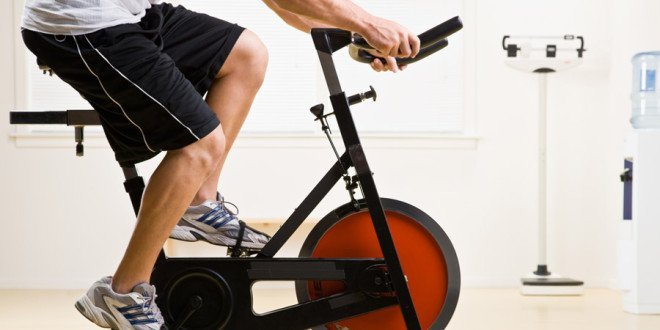Following a bicycling plan for weight loss is a great way to lose weight, build and tone your legs and get out in the fresh air!
Getting on your bike and going for a ride for 30 minutes or more is one of the most effective fat burning and stamina building activities.
I love cycling, whether out on the streets, off road or on a stationary cycle in a gym.
I’m not really built to run and have suffered on and off with shin splints for years. That’s why I got back on my bike.
Most of us stop riding a bike at some point during our teenage years.
I don’t know about you, but I went everywhere on my bike when I was a kid – to school, to my friends’ houses, into town…
Relearning the skill enabled me to get a really good workout and sort out my aching shins!
Why is a Bicycling Plan for Weight Loss so Effective…?
Cycling is primarily an aerobic activity. For more on aerobic exercise check out our information on the best exercise for weight loss.
Aerobic means with oxygen and is any moderate activity that raises your heart rate, makes you breathe a bit harder than usual and is continued for a few minutes or longer.
Most of the energy used to finance aerobic activity comes from body fat.
Cycle continuously for a period of time, ideally 20-30 minutes or longer and you’ll burn several hundred calories of body fat.
The more often you cycle, the fitter you’ll get and the more calories and fat you’ll burn.
Cycling is a non-weight bearing exercise, unlike jogging or aerobics which are impact exercises. As such, you can spare your joints the wear and tear that often results from the repeated impact of foot on tarmac, studio floor and so on.
Add in a few hills and you also work anaerobically – without oxygen.
Basically, if you force your body to work harder than your lungs and blood can supply your muscles with oxygen they work anaerobically.
Keep it up and lactic acid builds up in your working muscles, causing a ‘burn’.
You can’t keep this up for long, but as soon as you lower the intensity – free wheeling down a hill, for instance – the blood and oxygen flood the working muscle, clearing the lactic acid.
By varying the terrain over which you’re cycling – hills and flats, or the resistance on the stationary cycle, you switch between aerobic and anaerobic metabolisms, which is great for your overall fitness levels.
It stops your body getting used to what you’re doing and going on autopilot and forces it to constantly adapt to the varying stresses put on it.
Cycling is therefore a very effective way of interval training.
The other major benefit of following a bicycling plan for weight loss is that its a resistance exercise.
We’ve covered the benefits of weight training for weight loss, but cycling is also a great muscle building exercise.
Ride quickly or up an incline and you’ll engage your anaerobic metabolism. You’ll force your muscles to adapt by getting stronger. They’ll get a little bigger, firmer and more toned.
Increasing your lean muscle mass in this way raises your resting metabolic rate so you burn more calories at rest.
Your bicycling plan for weight loss is therefore a great way to build muscle.
A Bicycling Plan for Weight Loss – How Hard and How Often…?
Now let’s distinguish between a gentle ride to the shops and a training ride over a few miles, up and down a few inclines or across country.
The kind of ride that gets you out of breath and generates a burn in your thighs and calves!
To really benefit from a bicycling plan for weight loss you need to put some effort into it.
If you’ve not cycled for a while, take it easy to begin with.
You may also want get yourself checked out by your doctor to be on the safe side.
Invest in a helmet as well if you’re planning on riding outdoors. You won’t need one on the Lifecycle at the gym!
You’ll also need a bike to ride if you’ve not got one. Visit a decent bike shop and ask for some advice so as to get the right size for you.
Also decide whether you’ll be riding on or off road so you get the right kind of bike.
We’d suggest starting with a gentle 15-20 minutes ride on a flat circuit, preferably away from the traffic.
Look to cover at least 5 miles in 30 minutes – that’s a speed of 10 miles an hour.
A gentle 30 minutes bike ride will burn around 150 calories. A vigorous bike ride will burn at least double that.
Aim to cycle no less than three times a week and more often if you can.
Struggling for time? Try and build a bike ride into your busy routine. Cycling to and from work, to or from the train station for your daily commute…
Why not make it a family activity and go for a ride together at the weekend?
Once you’re into the groove, vary the terrain a bit – build in a few hills, gentle inclines to begin with then a few longer, steeper ones.
If cycling in the gym, start off with a manual programme and keep at a steady pace for the duration of the workout.
Once you’re used to it, switch to a programme that varies the resistance, simulating hills and downhill sections.
Bicycling Plan for Weight Loss – Convinced…?
For me, cycling has proven to be the most effective fat burning and conditioning exercise I have ever done.
It gets me out in the fresh air and has cured my shin splints and aching knees.
A word of caution, though. Cycling in traffic can be hazardous – dodging cars and trucks isn’t a great deal of fun. Breathing in traffic fumes is also a bad idea.
If you can, choose quieter roads or get out into the country.
If you live in the middle of a city, consider a stationary cycle instead. It can get a bit boring, so watch TV, listen to some music or read a book whilst you do it.
In summary, for us a bicycling plan for weight loss is a no-brainer. You’ll lose fat, build some muscle and get a great workout.
Build a bicycling plan for weight loss into your exercise regime and watch the pounds melt away!
If this article has whetted your appetite and you want to learn more about weight loss through bicycling, check out the cycling workouts, exercises and tips for diet and performance at the Cycling Fitness Center.
 Weight Loss for Busy People Best Fitness Blog
Weight Loss for Busy People Best Fitness Blog




